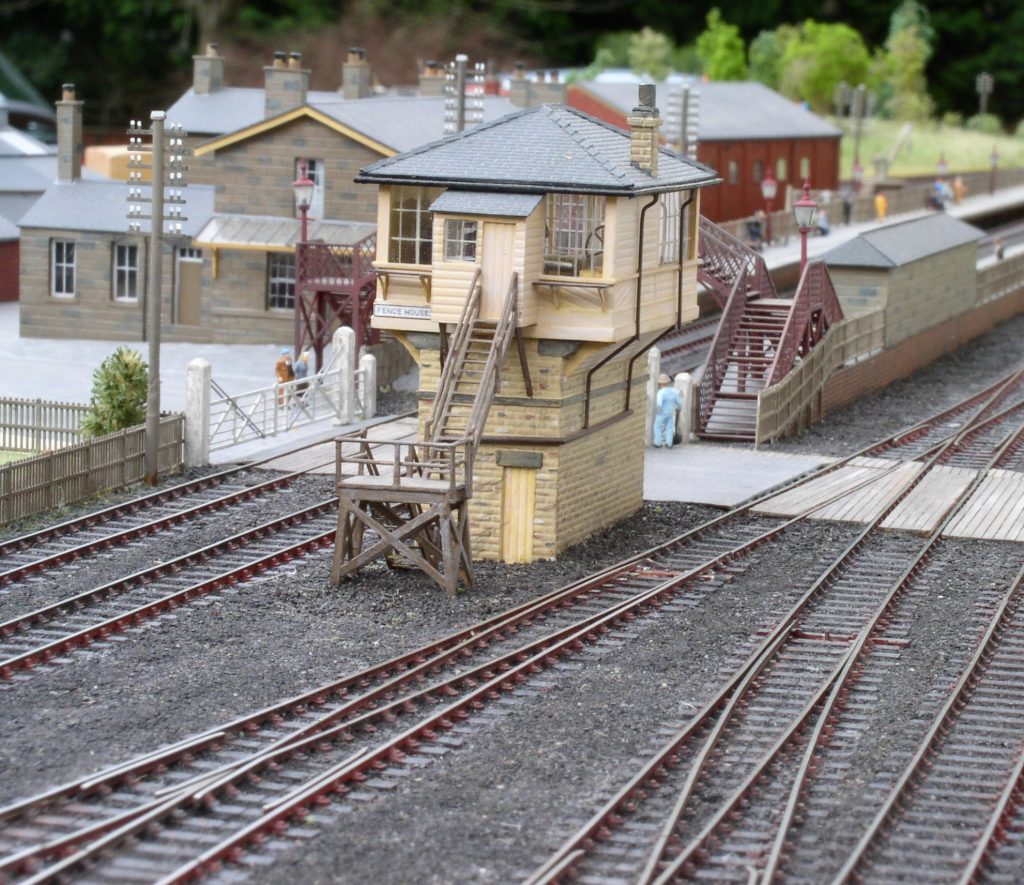Fence Houses

2mm/N Scale finescale,
Owner – Bob Jones
Contact Details – rvfjones@gmail.com
Dimensions – 11.7m x 2.7m (38’6″ x 9′)
Control Method – DCC
Fence Houses Station in north east England was once part of the original East Coast main line, but In 1872 this status was lost when the present main line was opened further west, through Durham City.
The station opened in 1844 and was closed in 1964.
Our layout is to scale in the station area, including the exchange sidings. Victoria viaduct is also to scale but is set to a 1.8m (6ft) radius curve as opposed to the real thing, which is straight.
The village & station of Penshaw (between Fence Houses & the viaduct) have been omitted due to lack of space, though we have included a very much reduced length of the four track section that lay between the ‘over track’ signal box of Penshaw North, and that of Wapping bridge, adjacent to the A183 road bridge, north of the colliery. The prominent double junction at Penshaw north was such an integral part of the track layout that it could not be ignored, and was modelled, though on the layout the branch line is going nowhere. In reality this line went to Sunderland, so please use your imagination! The Leamside line on which Fence Houses is sited was extensively used as a diversion route when such as engineering works were in progress on the main line. Our aim with the model is to show one such period when all main line traffic was being diverted during one weekend, sometime in the period 1952 to 1962. From time to time however, you may see some of our pre-grouping rolling stock that some members of the group indulge in making. This period is even more flexible (1890 to 1922).
This 2mm fine scale model was started in 2004 with the purchase of baseboard materials, and construction progressed slowly over the next two or three years by the efforts of the sole proprietor (Bob!) At that early stage of the layout’s development all control wiring was carried out using the conventional DC method.
Eventually the present team stated to form, or rather re-form in some cases as some people had been with me previously in the late 1970’s and early 1980’s when we first ‘did’ Fence Houses in ’N’ Gauge.
It quickly became evident that a layout of the extent and complexity of this 2mm fine scale model would benefit from the use of DCC (Digital Command Control), and this was adopted.
One thing that helped progress once the hand built track work was completed was the availability of the original Plastikard buildings from the 1980’s which were still in pretty good condition.
Three new buildings have been made since the original ‘N’ gauge layout all those years ago (Penshaw North Box, Fence Houses Post Office and the etched lattice Station platform footbridge).
We have working signals in place, mostly etched lattice kits but including some made from tube post and metal sections. All of them are controlled by servo operated mechanisms.
Scenery was created using various materials, including raiding the garden for some items and supplementing these with added ‘scatter’ material for the differing shades of vegetation.
Rolling stock is gradually and continuously being added as time allows, and this includes kit and scratch built locos, along with a number of ‘N’ gauge loco conversions, all DCC fitted.
Bachmann Farish coaches have been converted by the use of fine scale wheels, along with our own new etched model of the 1938 version of an articulated Gresley triplet restaurant set.
We have many superb 2mm etched kit built hoppers, bogie bolster and mineral wagons on view along with a growing stock of various vans etc.
You may well see one or two unfinished models being pressed into service, just to show you that we can build our own models as well as buy the odd few.
In addition to our data base command station our roving operators use iPhones and iPads for more flexibility (and fun!) of operation.
The original ‘N’ gauge Fence Houses layout was exhibited in the early 1980’s and some of you may remember it.
A model railway can take many years of refining to get where the builders want it to be. We hope you appreciate our efforts to date (with our second attempt).

